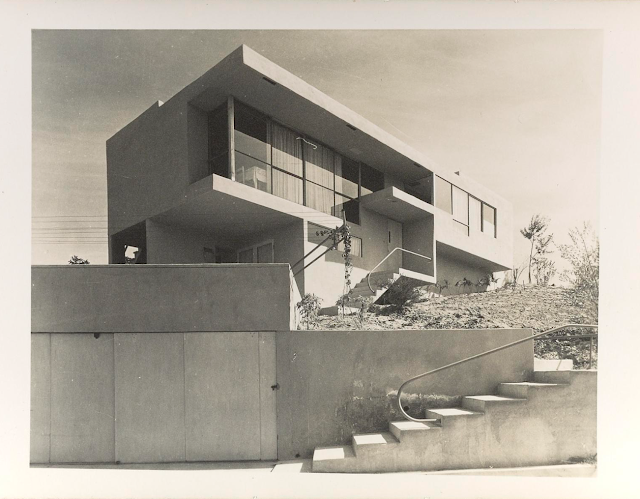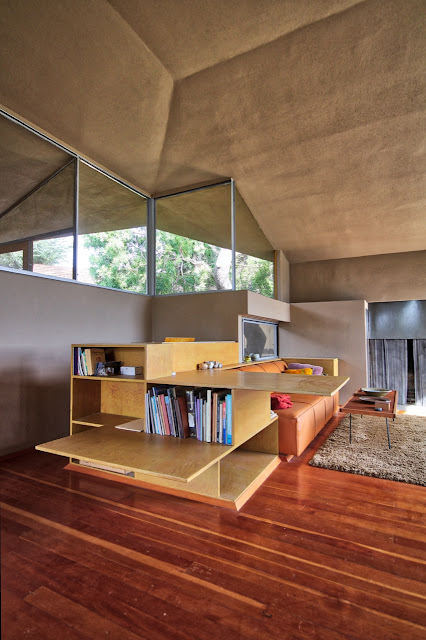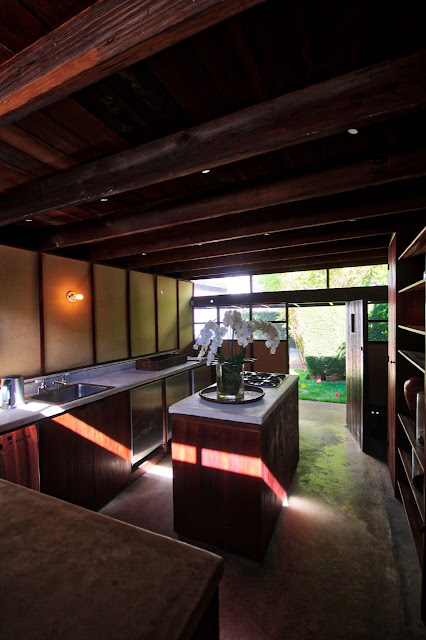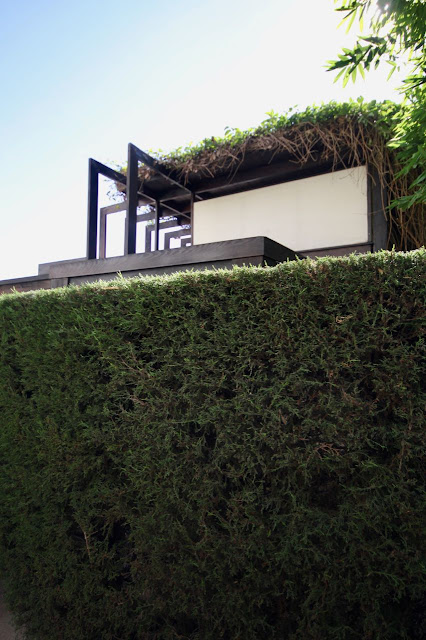I've
encouraged several architectural friends to visit the Schindler-Chace
house while they were in Los Angeles, and they've reported back that
they were not impressed.
What?!?!!!
Well,
OK: Maybe I get it. If you walk in 'naked', without context, the place
is rather shabby, maybe a spot to work on the '57 Chevy rather than
having the in-laws over for a long weekend. It doesn't have the wow
factor of Fallingwater, Villa Savoye, or the Rietveld-Schroeder House or
other Modern masterpieces in the area. It is, at first uneducated
glance, wholly unimpressive.
It
reminds me of when I sought to watch the 100 best movies of all time
and started with the consensus #1, Orson Welles' Citizen Cane. OMG what a
snoozer! I forced myself through that movie and, stunned by how 'bad'
it was, googled why the hell it is considered the best movie of all
time. After reading about it, it's brilliance became clear. Citizen
Cane's radical and innovative use of cinematography and storytelling
fundamentally changed movie-making thereafter. Yes, by today's
standards, it's dull; but it's dull in large part because what made it
radical at the time has been adopted by the world as a whole (and is
still in use today).
The
same is true of the Schindler-Chace House. Now I don't intend to
amplify Schindler's influence beyond what it is; He sadly pales beside
Le Corbusier, Frank Lloyd Wright, and Richard Neutra as far as direct
influence goes, but his contributions to Californian--and
American--Modern and how shockingly early he arrived at his style can't
be ignored.
The
first thing to note about this house is the year it was conceived:
1921. Read that again, but slowly: Nineteen. Freakin'. Twenty-one.
Construction finished in early 1922. Next, note what this house has
(honesty in materials, expression of structure, seamless integration
with the outdoors) and doesn't have (ornamentation).
At
that time, there were precious few structures that so purely embraced
the budding tenets of Modernism (Villa Sevensteyn in 1920-21 by W.
Dudok, Daal en Berg Houses by Jan Wils, various structures by Irving
Gill from 1907 to 1919 [although marred by sentimental mission-style
details], Villa Allegonda in 1917 by J.J.P. Oud, and several near-misses
by Adolf Loos [he of 'Ornament and Crime'] from 1910 to 1917, and Villa
Ganier in 1911 by Tony Ganier [marred by arches]). The Schindler-Chace
house is one of the first Modern houses built and the first Modern house
in the Western hemisphere.
I
know, I know: What about Frank Lloyd Wright? But Wright at that point
in his career (and even throughout it) was at best a proto-Modernist: He
still lathered his structures, by Modernist standards, with
ornamentation. Wright unquestionably influenced the Modern movement, but
he didn't create it and arguably didn't build his first fully-Modern
structure until 1934's Fallingwater, itself an architectural response to
Schindler, Neutra, and Corbusier and something of an anomaly in his
oeuvre.
Speaking
of Corbusier, he was just getting started as far as realized projects
were concerned with Ozenfant's house and studio in 1922. Neutra was
still an understudy to Erich Mendelsohn at the time and still 8 years
from 1929's Lovell Health House, and Mies van der Rohe didn't hit the
scene until 1923's concept for a concrete country house with his first
realized Modern with 1925's Wolf House.
Schindler
didn't work in a vacuum (no architect does). He studied at the heels of
Loos, admired and worked for Wright, and kept up with architectural
thought and advances in Europe. The Schindler-Chace House touches on all
of those influences: the lack of ornamentation (Loos), the desire for a
unique and organic North American architecture (Wright), and the theory
of Modernism (Europe) that he fused into his own architectural
manifesto. And what Schindler fused together from his influence and own
thoughts and built in North Hollywood (now LA) is remarkable.
Unfortunately,
being first isn't what it's all cracked up to be, so what he built
didn't get much attention at the time. Also, building on the west coast
meant that the east coast--a bit full of itself--ignored it. And
furthermore, building in the New World meant that the Old World--even a
bit fuller of itself--ignored it. Nonetheless, the house quietly
revolutionized architecture in California and the United States. First,
because Schindler and his wife Pauline were activists among the creative
class in Hollywood and the house was great for socializing, many
creatives, including potential clients and budding architects,
experienced the house firsthand. Second, because Schindler hosted Neutra
when Neutra first moved to the United States with his family, the house
and Schindler influenced the young Modernist architect who then went
on to steal clients and borrow ideas and concepts (Schindler borrowed
from Neutra as well). And third, believe it or not, Schindler influenced
Frank Lloyd Wright.
Wright
saw the Schindler-Chace house (and others Schindler designed and built)
and surely came away impressed. The last thing Wright's ego would ever
allow him to do is claim influence from a contemporary let alone someone
he considered hired help, but the similarities between Wright's later
work (for example, the Usonians) and Schindler's is unmistakable.
With
the Schindler-Chace House, Schindler had out-Wrighted Wright by
designing and building the ultimate in organic architecture. The house
evokes a Modern interpretation of the original North American
architectural voices with the slightly slanted concrete walls of Aztec
temples and the flat roofs of New Mexican the pueblos. Unadorned window
walls and transparent corners enhance the connection between indoors and
outdoors, a relationship consummated with large, sliding canvass walls
that reveal the outdoors as simply another room to enjoy. And this
revelation is non-hierarchical: The inside of the house is at the same
level as the outside--they are one and the same. Schindler had built the
first Californian Modern.
Yes, it's been done better later, including by Schindler. But this was the first,
and it was done without the technological advances and support (such as
large panes of glass, manufactured sliding doors) that benefited
subsequent designers and designs. The house is modest: Schindler was
just starting his practice and didn't have much money. But he was also
concerned with making the new architecture affordable to the masses (and
to his modest-means artist and progressive friends).
So
when you visit the Schindler-Chace House, consider the time and what
had or had not been done by that time. You may find yourself whispering
"Rosebud... Rosebud..." as you see this amazing place wrapped
comfortably with context...
----------
Whenever
we are in LA, we stop in at the Schindler House to pay respects and see
the house anew. Which is what we did on our last trip a couple months
ago. We had an architect and builder with us, so I was able to regale
(bore?) them with context before our visit.








 that floating roof!
that floating roof!


 looking back toward the house from the backyard. the roof canopy is not original
looking back toward the house from the backyard. the roof canopy is not original


 Wow!
Wow!
































































